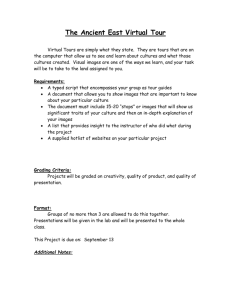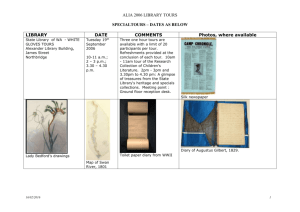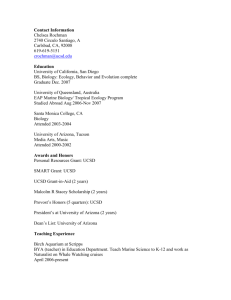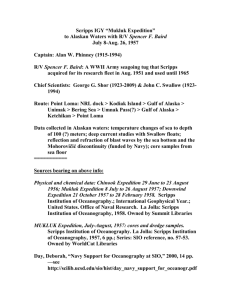SIO/UCSD tour options - the Marine Advanced Technology
advertisement
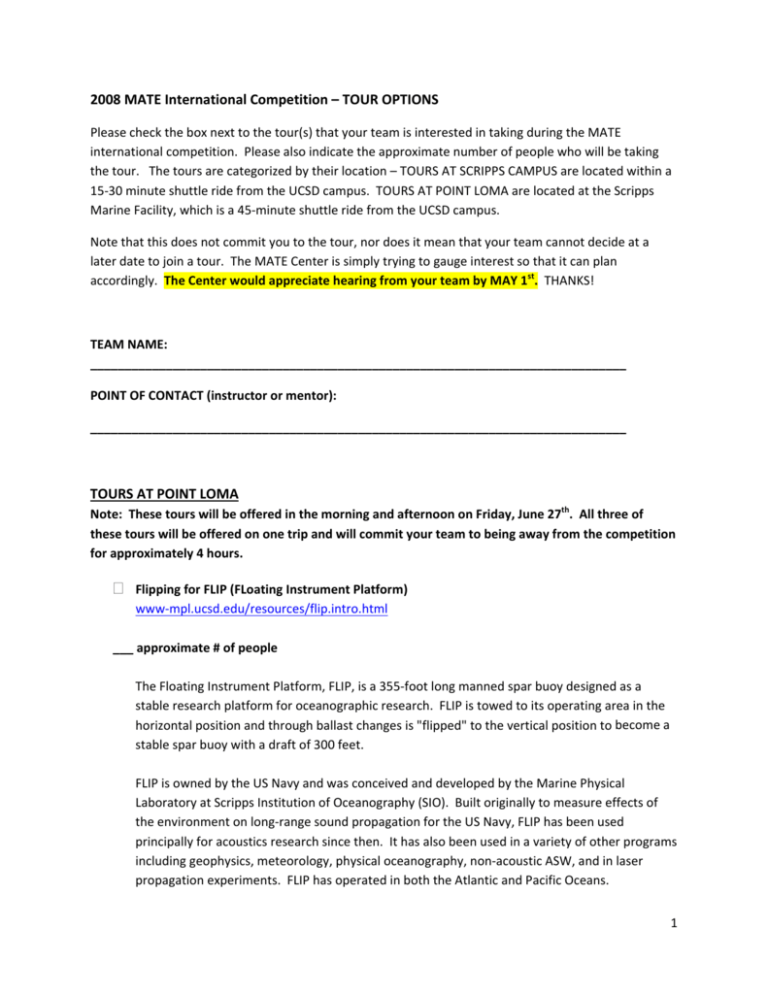
2008 MATE International Competition – TOUR OPTIONS Please check the box next to the tour(s) that your team is interested in taking during the MATE international competition. Please also indicate the approximate number of people who will be taking the tour. The tours are categorized by their location – TOURS AT SCRIPPS CAMPUS are located within a 15‐30 minute shuttle ride from the UCSD campus. TOURS AT POINT LOMA are located at the Scripps Marine Facility, which is a 45‐minute shuttle ride from the UCSD campus. Note that this does not commit you to the tour, nor does it mean that your team cannot decide at a later date to join a tour. The MATE Center is simply trying to gauge interest so that it can plan accordingly. The Center would appreciate hearing from your team by MAY 1st. THANKS! TEAM NAME: ______________________________________________________________________________ POINT OF CONTACT (instructor or mentor): ______________________________________________________________________________ TOURS AT POINT LOMA Note: These tours will be offered in the morning and afternoon on Friday, June 27th. All three of these tours will be offered on one trip and will commit your team to being away from the competition for approximately 4 hours. Flipping for FLIP (FLoating Instrument Platform) www‐mpl.ucsd.edu/resources/flip.intro.html ___ approximate # of people The Floating Instrument Platform, FLIP, is a 355‐foot long manned spar buoy designed as a stable research platform for oceanographic research. FLIP is towed to its operating area in the horizontal position and through ballast changes is "flipped" to the vertical position to become a stable spar buoy with a draft of 300 feet. FLIP is owned by the US Navy and was conceived and developed by the Marine Physical Laboratory at Scripps Institution of Oceanography (SIO). Built originally to measure effects of the environment on long‐range sound propagation for the US Navy, FLIP has been used principally for acoustics research since then. It has also been used in a variety of other programs including geophysics, meteorology, physical oceanography, non‐acoustic ASW, and in laser propagation experiments. FLIP has operated in both the Atlantic and Pacific Oceans. 1 Note: This tour is also available the afternoon of Wednesday, June 25th. Check the box here if you are interested in this time slot ONLY. ___ approximate # of people FLIP flipped at sea Glide on into the Marine Physical Laboratory’s (MPL) AUV Lab www.mpl.ucsd.edu/resources/instrumentation/auv.html ___ approximate # of people The MPL’s AUV lab is where ROVs and AUVs are designed and constructed for many of SIO science research programs. The lab is staffed by a team of engineers who specialize in oceanographic instrumentation. The engineers design and build the AUVs on shore in the lab, test them, then assist scientists who want to use them to collect data at sea. Currently, the lab is focusing on 2 AUV projects. One is designing a wing‐shaped underwater glider AUV for the Office of Naval Research (ONR). The other is a propeller‐driven AUV called the Bluefin 21 that is used for various oceanographic research projects. The lab is continually testing, refining, and redesigning these AUVs as technology develops and scientists have a need for new platforms for data collection at sea. The Bluefin 21 AUV can be equipped with different scientific instruments depending on the particular science project for which is it being used. 2 Bluefin 21 AUV at sea ROV in need of repair? The R&D Shop can fix it – and a whole lot more http://www‐mpl.ucsd.edu/resources/shop.facilities.html ___ approximate # of people The MPL’s Research and Development (R&D) Shop consists of 18,000 square feet inside and outside the machine shop. The MPL R&D Shop also has special facilities for conducting equipment pressure tests, circuit board fabrication, and plastic potting. The shop also maintains an environmental test chamber. TOURS AT SCRIPPS CAMPUS Note: These tours will be offered in the morning and afternoon on Saturday, June 28th. All three of these tours will be offered on one trip and will commit your team to being away from the competition for approximately 3 hours. Rocking and rolling in the OBS Lab http://www‐mpl.ucsd.edu/obs/ ___ approximate # of people EXPLORER class teams practiced rescuing a simulated ocean bottom seismometer (OBS) as part of their ROV competition mission tasks – now see the real thing! To further Navy needs and to serve the broader scientific community, the ONR supported the design and construction of OBS instruments and established instrument two centers; one at the SIO and the other at the Woods Hole Oceanographic Institution. Both centers maintain fleets 3 OBSs and associated equipment as a shared resource for use by the members of the scientific community. The facilities are operated on a self‐supporting basis, with support from the marine programs of the National Science Foundation and the ONR. The real thing – an OBS designed and built by Scripps engineers Did you bring enough tether? Launching a tour on the SIO Pier http://www.sio.ucsd.edu/About/Scripps_Overview/History/Scripps_Pier/ ___ approximate # of people As one of the world's biggest research piers, the Ellen Browning Scripps Memorial Pier is used for boat launching and a variety of experiments. Data on ocean conditions and plankton taken from the pier since 1915 provide an unparalleled source of information on changes in the coastal Pacific Ocean. The pier also provides a supply of fresh seawater, a critical resource for a marine institution, to an array of laboratories and aquaria. Approximately one‐quarter mile long, the pier provides a fitting backdrop to learn more about the history of the institute and UCSD. Looking back on the hillside, the pier also offers a breath‐ taking view of the SIO campus. 4 SIO pier at sunset Something’s fishy at the SIO Marine Vertebrate Collection http://collections.ucsd.edu/mv/index.cfm ___ approximate # of people The Marine Vertebrate Collection of SIO maintains approximately 2 million alcohol‐preserved specimens in well over 100,000 lots, representing more than 5,500 species of fishes. The Collection maintains worldwide holdings of deep‐sea and pelagic fishes as well as extensive holdings of shore fishes from the entire eastern Pacific. Specimens are used by SIO researchers and are loaned to institutions around the world. Deep‐sea anglerfish – one of the residents in the SIO collection 5
